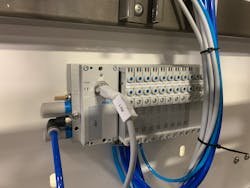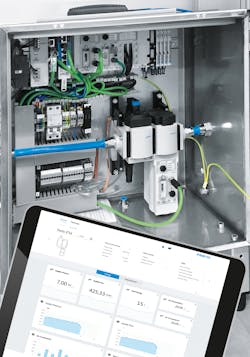People have always yearned to predict the future. And now water industry personnel can do just that using predictive analytics to anticipate component failure before it shuts down a process. Predictive data comes from smart devices that may already be in operation at the plant or on a skid. And if not there yet, these smart devices can be quickly, easily, and cost effectively installed. Predictive analytics is not an all or nothing proposition. Water system operators can add predictive analytic capabilities at their own pace.
Supervisory Control and Data Acquisition (SCADA) Systems monitor the status of a process and convey immediate notification when a component or process has failed. However, condition monitoring — the health of the component — is not typically the emphasis. Acquiring component health data, which is the basis of predictive analytics, is the natural next step in SCADA system effectiveness.
How Do These Systems Operate?
In the majority of industries, components are serviced on preventive maintenance schedules and/or replaced when they fail. In critically important systems, replacement after failure typically means the system is completely shut down until the repairs are completed. Predictive analytics relies on having the right tools in place to anticipate maintenance or service events before they shut down the process. For example, smart sensors can constantly measure the current used by a critically important pump. Threshold parameters for the current can be set. When the current rises above the threshold, operators know the pump is wearing out. The pump may function for weeks or even months after first indicating the current is above the threshold, but it will eventually stop working. With current-draw information, operators can decide when to service or replace it. Predictive analytics places operations in charge of when the plant is shut down and reduces operational uncertainty. Fewer spare parts need to be purchased and stockpiled for emergencies.
Similar to how a doctor monitors various functions of a patient based on the patient’s history, smart sensors can monitor a host of vital functions unique to the component or process with flow, temperature, distance traveled, pressure, and duration measurements being the most common.
How to Start Applying Predictive Analytics
Think of predictive analytics as monitoring the health of the operation by acquiring and analyzing vital data on key components. To identify candidates for monitoring, use history as a guide. Look back at instances when the plant was placed in a difficult situation because a component quit unexpectedly. Determine the data that, had it been available, would have indicated a failure was days, weeks, or even months away. With the component and data identified, find out whether the condition data required is already resident in the system, just simply not being collected, and begin gathering that data. Or, if the data is not available, add a smart sensor, set thresholds, and begin monitoring. The predictive analytics program has begun.
Ethernet-based communication systems have a wealth of data buried within the system and unless uncovered it is not utilized. Inquire of the component vendor, the skid original equipment manufacturer (OEM), and/or engineering firm whether this is the case. For example, there may be dozens of parameters available for monitoring an Ethernet-based variable frequency drive (VFD), but until now, perhaps, no one thought to access critical data and set threshold alerts.
IO-Link-Enabled Technology
IO-Link is the first worldwide standardized IO technology (IEC 61131-9) for communication with sensors and actuators. This powerful point-to-point communication standard is based on the long established 3-wire sensor and actuator connection, which makes installation familiar. There are several aspects of IO-Link enabled sensors and actuators that everyone should be aware of, and there are three types of data available in IO-Link sensors and actuators.
- IO-Link devices carry event data that flags or notifies when critical events occur.
- IO-Link devices have service data, including all the vital information about the unit such as manufacturer, model, and serial number. Service data also includes parameter values which are listed by the device and can be changed via the controller. Plug in a replacement device and the controller will automatically load parameters, saving time and lowering the chance of error.
- IO-Link devices offer condition data such as temperature, distance, proximity, current, and media flow.
In a predictive analytic environment, the correct IO-Link device for the condition monitoring need is an ideal predictive analytic tool. There are a host of additional installation and commissioning advantages not covered here that make IO-Link fast, easy, and cost effective to apply. Since IO-Link is an open standard, devices from different vendors are interoperable and the end user is not locked into one vendor’s solution.
Other Enabling Systems and Considerations
New remote I/O systems are a vital and cost-effective means of driving intelligence deeper into the system to acquire condition information, while making component installation faster and easier. Remote I/O boosts system performance improvements through faster overall automated response.
Other components contributing to predictive analytics include Industrial Internet of Things (IIoT) ethernet gateways. Gateways push data to cloud-based dashboards. Dashboards provide easy monitoring and benchmarking by authorized personnel via mobile and desktop devices. Trends can be analyzed, early warnings issued, and incident notifications set up. This in-context information is a powerful means of communicating the actual real-time situation.
An important attribute of gateways is that they run autonomously from the controller and simply push data out to a dashboard, receiving no inputs from the outside. There is no risk to a process or skid of outside influence being pushed in. This is a key consideration for security-conscious operations. Security is paramount, and ethernet gateways are not suitable for every organization or situation, but available and useful where appropriate for immediate, safe access to information anywhere and anytime.
Use Predictive Analytics to Save Energy
Compressed air is a clean, safe, and readily available source of energy for automated processes in the water industry. Considerable electricity is required to generate compressed air and consumption contributes to the operation’s environmental footprint and utility costs. Improving the monitoring of compressed air is a best practice that can immediately reduce plant costs and alert plant personnel to failing systems.
The standard convention for monitoring compressed air has been limited to pressure sensors on the air preparation units. Measuring air pressure only addresses part of the equation. Air flow rates and volumetric consumption are also vital for understanding the total compressed air environment. Smart components are now available that monitor all the critical variables in predictive analytic systems. These smart components seamlessly integrate with existing air preparation units. Data can be used to enhance operational efficiency, reduce compressed air consumption, and point out system issues, including wasteful leaks.
Talk with key suppliers. Ask them how they may be using or plan to use smart sensors and actuators and data incorporated within Ethernet-based systems to move toward predictive analytics. The cost of instrumentation and automation continues to decrease. Obtain an understanding from the key component and system vendors of what they recommend in terms of acquiring diagnostic capabilities. In requests for proposals, include a call for predictive analytic solutions. Start internal programs by incorporating condition monitoring on strategic components. The goal is to put plant personnel in control of when the operation is running and when it’s not and to ultimately eliminate unplanned shutdowns. WW
About the Author

Brock Emerson
Brock Emerson is a professional engineer working in the water treatment industry. Currently, he is the Chief Operating Officer at Intuitech. As COO, he actively manages the day-to-day administration of the organization and is responsible for overseeing engineering, procurement, fabrication, and project management in the delivery of package and pilot treatment solutions for the water industry. He holds a BS in Mechanical Engineering as well as a MS in Environmental Engineering and an Executive MBA. He is an active AWWA member, serving as the Chair of the Coagulation and Filtration Committee on the Association level and as member of the Intermountain Section Board of Directors.

Nate Ventress
Nate Ventress is a water industry lead and process industries segment specialist at Festo. He has 20 years of experience in fluid power and automation. After achieving a technical degree in fluid power technology, he spent a decade developing and supporting automation solutions for the semiconductor and solar equipment industry in Silicon Valley, Calif. For the past 15 years, he’s had various business development roles within Festo, across multiple industry segments. Since 2010, Ventress has been focused specifically on process industries business development and has specialized in the automation of water treatment processes.

